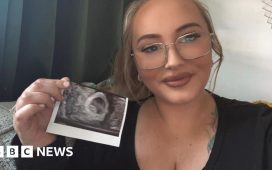America’s face mask policy has been branded ‘outdated’ and unscientific as a DailyMail.com analysis shows most states are still recommending them to protect against Covid.
Last week, an infectious disease doctor who advises the UK Government testified there was no proof face coverings stopped viral transmission and may have even raised the risk of getting infected because it gave people a ‘false sense of security.’
The expert’s testimony came after numerous reviews – including one by the esteemed Cochrane Institute – that failed to find solid evidence masks reduced Covid cases, hospital admissions or deaths globally during the pandemic.
Yet in the US, the Centers for Disease Control and Prevention (CDC) is still recommending masks for people in areas where the community spread is elevated and hospital admission levels are high.
And an analysis of state health department guidance shows 31 states are either outright recommending masks for people who are high risk or refer to the CDC’s recommendation.

The CDC ‘s face covering recommendations vary based on the hospital admission level in an area – and 31 states follow suit. Red states indicate those that follow the CDC’s recommendations and tan states indicate those who do not recommend or have limited face mask recommendations

Director of the CDC Dr Mandy Cohen refused to tell House lawmakers last week that the agency would not once again recommend face masks for children as young as two years old
Dr Monica Gandhi, an infectious disease expert at the University of California San Francisco, told DailyMail.com the CDC has been too ‘slow’ to catch up with the science.
Dr Gandhi, who initially supported masks in the beginning of the pandemic due to the ‘unknown’ nature of the virus, said there is now ‘too much evidence’ and literature supporting not using masks over implementing widespread mask use.
She told DailyMail.com the CDC needs to ‘reevaluate its outdated guidelines’ and remove widespread masking recommendations.
The CDC says that when Covid hospital admission levels are low – fewer than 10 per 100,000 people – the CDC says ‘people may choose to wear a mask at any time.’
When levels are medium to high – 10 to 19.9 admissions per 100,000 people – the CDC states: ‘If you are at high risk for getting very sick, wear a high-quality mask or respirator.
‘If you have household or social contact with someone at high risk getting very sick… consider wearing a mask when indoors with them.’
When levels are high – 20 or more admissions per 100,000 people – the CDC says everyone should ‘wear a high-quality mask or respirator’ and high-risk individuals should consider avoiding non-essential indoor public activities.
Tom Jefferson, an epidemiologist who was the lead author of the Cochrane mask review, said: ‘There is just no evidence that they — masks — make any difference.’

The above shows the Covid hospital admission levels in the US by county per 100,000 people. The CDC’s face covering recommendations vary based on the hospital admission level in an area

The above shows currently hospitalized Covid-19 patients (blue bars) and the weekly new Covid-19 hospital admissions per 100,000 people (yellow line)
He told journalist Dr Maryanne Demasi that even the tougher N95 mask ‘makes no difference’ and that studies mask advocates cited to support mandates were ‘flawed observational studies.’
Currently, the majority of the US is under the CDC’s definition of ‘low’ for Covid hospital admissions.
States including Arizona, California, Connecticut, Kansas, Maine, Montana, New Jersey, New York, Oregon, Texas, Vermont and Wisconsin all either outline guidance similar to that of the CDC or link out to the CDC’s website when outlining their recommendations.
This means nearly half of Americans across the country are advised to mask up as hospitalizations increase.
In the 2020 presidential election, all of these states, excluding Kansas and Texas, voted Democratic, the party that has long supported mask mandates and pushed the narrative that masks stop the spread of Covid.
States including Alabama, Florida – Republican states – and Nevada don’t have any guidance on mask-wearing.
In Washington state, the health department defers to CDC guidance, but adds that high-risk people cover their nose and mouth when on public transportation.
New Mexico recommends people at high-risk mask when the spread of the virus is elevated in their area.
Massachusetts tells people to consider a mask anytime if they have a weak immune system or are caring for someone at high risk of severe infection.
Kentucky has similar guidelines, with the health department saying people should consider masking up if they are at high risk for serious illness during respiratory disease season.
It comes after Professor Dame Jenny Harries, who leads the UK’s Health Security Agency, said recently evidence that masks reduced transmission is ‘uncertain’ because it is difficult to separate their effect from other Covid curbs.
Dame Jenny cited studies that have shown at least three masks were needed for even a small effect on the spread of viruses.

The above shows the percent positivity of Covid-19 tests in the past week in different regions of the US

Researchers looked at 78 studies involving more than one million people across the world. Results indicated that surgical masks reduced the risk of catching ‘Covid or a flu-like illness’ by just five percent – a figure so low it may not be statistically significant
She wrote the basis for using face masks in the community ‘was, and still is to some degree, uncertain,’ noting evidence varied depending on what materials it was made from.
For example, a ‘one or two layer cloth covering’ is ‘not particularly effective’, she said.
And if someone doesn’t wear it properly – fully covering the mouth and nose – ‘it won’t work’, Dame Jenny added.
However, in the US, Director of the CDC Dr Mandy Cohen refused to tell House lawmakers last week that the agency would not once again recommend face masks for children as young as two years old.
The CDC said in a statement to DailyMail.com: ‘The science of masking and its impact on SARS-CoV-2 transmission is complex, but the evidence is compelling that wearing masks helps prevent the spread of respiratory disease.
‘Well-fitting, properly used masks reduce the spread of COVID-19, especially when worn by the majority of the population during times of high community transmission.
‘Masks are a valuable tool to protect people at high risk of getting very sick with COVID-19 and reduce transmission during times of high community spread. Mathematical modeling tools show that studies consistently support the effectiveness of masks in reducing COVID-19 cases.’
Last winter, as cases rose in places across the US, cities like New York, Boston and Philadelphia recommended its residents begin to mask up again.
In December 2022, Washington state, Los Angeles and New York City all urged people to wear face coverings as it battled the winter ‘tripledemic’ of flu, RSV and Covid.
Philadelphia reinstated indoor mask requirements in schools for two weeks in January.
As recently as September, New York City was encouraging its more than 8million residents to wear masks ahead of the Labor Day weekend as the city dealt with a rise in Covid cases and hospitalizations.
While federal and state health departments stress the importance of masks, the Cochrane Institute analysis of 78 global studies involving more than 1million people found surgical masks reduced the risk of catching ‘Covid or a flu-like illness’ by just five percent – a figure so low it may not be statistically significant.
A separate Danish study in the spring of 2020 with more than 6,000 participants found wearing a mask made no statistical difference to whether or not people got Covid, but its researchers struggled to find a prominent journal willing to publish the results.
In addition to studies finding face masks don’t work, separate ones have also found that face coverings could actually cause harm.
Authors of a review of dozens of studies on face coverings suggested they can cause mild carbon dioxide poisoning when worn over long periods.
Covid is no longer the deadly threat it once was. While weekly new hospital admissions involving the virus have been rising for three weeks – hitting 19,400 during the week ending Nov. 25 – they are still nearly eight times lower than levels seen at the peak in January 2022 and deaths are about 60 times below the peak in late 2020.
Many doctors now compare the virus to the common cold or the flu, which while disruptive and deadly among vulnerable groups, will not cause serious illness in the vast majority of people.
The transition from deadly virus to manageable seasonal illness can be attributed to the high levels of immunity among Americans from previous infection or vaccination, plus an arsenal of highly-effective therapies and drugs.
For these reasons the federal government declared the pandemic over in May this year and ended the public health emergency, scrapping legal requirements to mask, isolate, test and get vaccinated.









